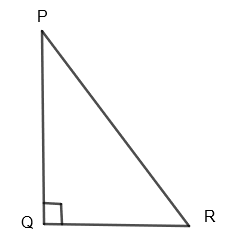
PQR is a right-angled isosceles triangle, right-angled at Q, then prove that
\[P{{R}^{2}}=2P{{Q}^{2}}\]
Answer
516.9k+ views
Hint: In this question, we are given that the triangle is isosceles and so we can write PQ = QR. Then, apply the Pythagoras Theorem to the equation and put PQ = QR to get the desired results.

Complete step-by-step answer:
In this question, we are given that PQR is a right-angled isosceles triangle which is right-angled at Q, i.e. \[\angle PQR={{90}^{o}}\]. First of all, we will draw the figure,
In triangle PQR, \[\angle PQR={{90}^{o}}\], so PQ will be equal to QR and less than PR. So in the triangle PQR, we will apply Pythagoras Theorem. Before proceeding with the question, we need to know what Pythagoras theorem is. Pythagoras Theorem explains the relation between the sides of a right-angled triangle. This theorem is used for right-angled triangles. In this theorem, the sum of the squares of the two sides is the square of the third side. Generally, this theorem is used to find the third side of the triangle when two of the sides are given.
So now, we will apply this Pythagoras theorem in the triangle PQR, so we will write it as,
\[P{{Q}^{2}}+Q{{R}^{2}}=P{{R}^{2}}....\left( i \right)\]
As we know that PQR is an isosceles triangle, so we can say that PQ = QR. So now, instead of QR, we will substitute PQ in equation (i), we get,
\[P{{Q}^{2}}+P{{Q}^{2}}=P{{R}^{2}}\]
So, we get, \[2P{{Q}^{2}}=P{{R}^{2}}\]
Hence proved.
Note: Students should be careful while applying the Pythagoras theorem as they should know the conditions before applying it and also they should know the properties of the triangle so that it's easier to answer the question.

Complete step-by-step answer:
In this question, we are given that PQR is a right-angled isosceles triangle which is right-angled at Q, i.e. \[\angle PQR={{90}^{o}}\]. First of all, we will draw the figure,
In triangle PQR, \[\angle PQR={{90}^{o}}\], so PQ will be equal to QR and less than PR. So in the triangle PQR, we will apply Pythagoras Theorem. Before proceeding with the question, we need to know what Pythagoras theorem is. Pythagoras Theorem explains the relation between the sides of a right-angled triangle. This theorem is used for right-angled triangles. In this theorem, the sum of the squares of the two sides is the square of the third side. Generally, this theorem is used to find the third side of the triangle when two of the sides are given.
So now, we will apply this Pythagoras theorem in the triangle PQR, so we will write it as,
\[P{{Q}^{2}}+Q{{R}^{2}}=P{{R}^{2}}....\left( i \right)\]
As we know that PQR is an isosceles triangle, so we can say that PQ = QR. So now, instead of QR, we will substitute PQ in equation (i), we get,
\[P{{Q}^{2}}+P{{Q}^{2}}=P{{R}^{2}}\]
So, we get, \[2P{{Q}^{2}}=P{{R}^{2}}\]
Hence proved.
Note: Students should be careful while applying the Pythagoras theorem as they should know the conditions before applying it and also they should know the properties of the triangle so that it's easier to answer the question.
Recently Updated Pages
The correct geometry and hybridization for XeF4 are class 11 chemistry CBSE

Water softening by Clarks process uses ACalcium bicarbonate class 11 chemistry CBSE

With reference to graphite and diamond which of the class 11 chemistry CBSE

A certain household has consumed 250 units of energy class 11 physics CBSE

The lightest metal known is A beryllium B lithium C class 11 chemistry CBSE

What is the formula mass of the iodine molecule class 11 chemistry CBSE

Trending doubts
Fill the blanks with the suitable prepositions 1 The class 9 english CBSE

Difference Between Plant Cell and Animal Cell

Draw an outline map of India and mark the following class 9 social science CBSE

Differentiate between the Western and the Eastern class 9 social science CBSE

What is pollution? How many types of pollution? Define it

Distinguish between Khadar and Bhangar class 9 social science CBSE




